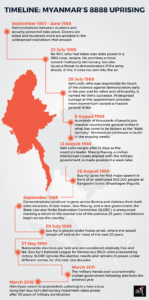About 8888 Uprising
- It was a series of nationwide protests, marches and civil unrest in Burma (Myanmar) that peaked in August 1988.
- Columns of demonstrators from all walks of life stood united under the emblem of the fighting peacock which would go on to become a powerful symbol of democracy in the country.
- Goal Of Uprising- ousting a dictatorial regime under which the country had been systematically oppressed since 1962.
- Two-fold objective Uprising
- To push for the transfer of power from the military to a civilian leadership
- Change in the political system from an authoritarian regime to a multi-party democracy.
- Events occurred on 8 August 1988 and therefore it is known as the 8888 Uprising.
- ‘8888’ was a people’s movement that challenged the then ruling Burma Socialist Programme Party’s grip on political, economic and social affairs which led the country into extreme poverty.
- Troops known as the Tatmadaw began opening fire on protestors. In the weeks that followed, at least 3,000 demonstrators died as a result and thousands more were jailed. The military then took firm control of the government and initiated further crackdowns in September.
Outcomes of the uprising
- The protests and the bloody crackdown gave rise to the National League for Democracy (NLD), a political party which paved the way for the current Myanmar State Counsellor, Aung San Suu Kyi’s entry into politics and for the pro-democracy movement to continue.
- On 26 August 1988, she stood outside the iconic Shwedagon Pagoda and addressed an estimated crowd of 500,000 people on the urgent need for the nation to transition to a democracy after an unsuccessful experiment with socialism.
- Suu Kyi was placed under house arrest in 1989 and a year later, her party, the National League for Democracy (NLD) won a resounding victory in the national polls – sweeping 80 percent of the seats in parliament and 60 percent of the popular vote. However, the military led government there ignored the election results and remained in power for another two decades.
Present set up In Myanmar
- The democratic transition in Myanmar meticulously designed by the military,primary objective, laid out in the country’s 2008 Constitution, is to give the military a dominant role in politics.
- In a parallel to the ‘Burmese way to socialism’ introduced by former military leader Ne Win in the 1960s.
- Myanmar now practices ‘Burmese way to democracy’ as introduced by former Prime Minister Khin Nyunt in 2003 when he announced the military’s seven-step road map to a flourishing democracy.

Additional Link:https://journalsofindia.com/myanmars-struggle-for-democracy/
















